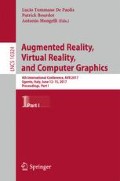Abstract
Portable depth-sensing cameras allow users to control interfaces using hand gestures at a short range from the camera. These technologies are being combined with virtual reality (VR) headsets to produce immersive VR experiences that respond more naturally to user actions. In this research, we explore gesture-based interaction in immersive VR games by using the Unity game engine, the LeapMotion sensor, a laptop, a smartphone, and the Freefly VR headset. By avoiding Android deployment, this novel setup allowed for fast prototyping and testing of different ideas for immersive VR interaction, at an affordable cost. We implemented a system that allows users to play a game in a virtual world and compared placements of the leap motion sensor on the desk and on the headset. In this experimental setup, users interacted with a numeric dial panel and then played a Tetris game inside the VR environment by pressing the buttons of a virtual panel. The results suggest that, although the tracking quality of the Leap Motion sensor was rather limited when used in the head-mounted setup for pointing and selection tasks, its performance was much better in the desk-mounted setup, providing a novel platform for research and rapid application development.
Access this chapter
Tax calculation will be finalised at checkout
Purchases are for personal use only
References
Adhikarla, V.K., Sodnik, J., Szolgay, P., Jakus, G.: Exploring direct 3d interaction for full horizontal parallax light field displays using leap motion controller. Sensors 15(4), 8642–8663 (2015)
Arthur, K.W.: Effects of field of view on performance with head-mounted displays. Ph.D. thesis, University of North Carolina at Chapel Hill (2000)
Bachmann, D., Weichert, F., Rinkenauer, G.: Evaluation of the leap motion controller as a new contact-free pointing device. Sensors 15(1), 214 (2015). http://www.mdpi.com/1424-8220/15/1/214
Barret, J., Krueger, H.: Performance effects of reduced proprioceptive feedback on touch typists and casual users in a typing task. Behav. Inf. Technol. 13(6), 373–381 (1994). http://dx.doi.org/10.1080/01449299408914618
Beattie, N., Horan, B., McKenzie, S.: Taking the leap with the oculus HMD and CAD - plucking at thin air? In: Proceedings of The 1st International Design Technology Conference, DESTECH2015, vol. 20, pp. 149–154. Elsevier (2015). http://www.sciencedirect.com/science/article/pii/S2212017315002029
Besacier, G., Tournet, J., Goyal, N., Cento, F., Scott, S.D.: Object and arm shadows: Visual feedback for cross device transfer. In: CHI 2014 Extended Abstracts on Human Factors in Computing Systems, pp. 463–466, CHI EA 2014. ACM Press, New York (2014) http://doi.acm.org/10.1145/2559206.2574832
Clark, T.: How Palmer Luckey created Oculus rift, November 2014. http://www.smithsonianmag.com/innovation/how-palmer-luckey-created-oculus-rift-180953049/?no-ist/
Edward, B.: Unraveling the enigma of Nintendo’s virtual boy, 20 years later, August 2015. http://www.fastcompany.com/3050016/unraveling-the-enigma-of-nintendos-virtual-boy-20-years-later/
FreeflyVR: Freefly VR: how does it work, the complete guide (2014). https://www.freeflyvr.com/freefly-vr-how-it-works/
Google Inc.: Google cardboard Google VR (2016). https://www.google.com/get/cardboard/
Greene, E.: Augmenting visual feedback using sensory substitution. Master’s thesis, University of Waterloo (2011). https://uwspace.uwaterloo.ca/bitstream/handle/10012/6161/Greene_Eugene.pdf
Guna, J., Jakus, G., Poganik, M., Tomai, S., Sodnik, J.: An analysis of the precision and reliability of the leap motion sensor and its suitability for static and dynamic tracking. Sensors 14(2), 3702 (2014). http://www.mdpi.com/1424-8220/14/2/3702
Higuchi, M., Komuro, T.: [Paper] robust finger tracking for gesture control of mobile devices using contour and interior information of a finger. ITE Trans. Media Technol. Appl. 1(3), 226–236 (2013)
Hilfert, T., König, M.: Low-cost virtual reality environment for engineering and construction. Vis. Eng. 4(1), 1–18 (2016). http://dx.doi.org/10.1186/s40327-015-0031-5
HTC Corporation: Vive - Home (2016). https://www.htcvive.com/ca/
Hu, H.H., Gooch, A.A., Thompson, W.B., Smits, B.E., Rieser, J.J., Shirley, P.: Visual cues for imminent object contact in realistic virtual environment. In: Proceedings of the Conference on Visualization 2000, pp. 179–185, VIS 2000. IEEE Computer Society Press, Los Alamitos (2000). http://dl.acm.org/citation.cfm?id=375213.375238
Intel Corp.: Intel RealSense Technology. http://www.intel.com/content/www/us/en/architecture-and-technology/realsense-shortrange.html (2016)
Leap Motion Inc.: How Does the Leap Motion Controller Work? (2016). http://blog.leapmotion.com/hardware-to-software-how-does-the-leap-motion-controller-work/
Leap Motion Inc: Leap motion developers (2016). https://developer.leapmotion.com/unity/
Noobtuts.com: Unity 2D Tetris Tutorial (2012). http://noobtuts.com/unity/2d-tetris-game/
Occipital, Inc.: Structure Sensor - 3D scanning, augmented reality, and more for mobile devices (2016). http://structure.io/
OculusVR: Oculus (2016). https://www.oculus.com/en-us/
Samsung Corporation: Samsung gear VR - the official Samsung galaxy site (2016). http://www.samsung.com/global/galaxy/wearables/gear-vr/
Sharp, T., Keskin, C., Robertson, D., Taylor, J., Shotton, J., Kim, D., Rhemann, C., Leichter, I., Vinnikov, A., Wei, Y., Freedman, D., Kohli, P., Krupka, E., Fitzgibbon, A., Izadi, S.: Accurate, robust, and flexible real-time hand tracking. In: Proceedings of CHI, the 33rd Annual ACM Conference on Human Factors in Computing Systems. ACM Press, April 2015. http://research.microsoft.com/apps/pubs/default.aspx?id=238453
Sony Interactive Entertainment: PlayStation VR (2016). https://www.playstation.com/en-ca/explore/playstation-vr/
Splashtop Inc.: Top-performing remote desktop and remote support (2016). http://www.splashtop.com/
Weichert, F., Bachmann, D., Rudak, B., Fisseler, D.: Analysis of the accuracy and robustness of the leap motion controller. Sensors 13(5), 6380 (2013). http://www.mdpi.com/1424-8220/13/5/6380
Welch, G., Bishop, G.: Scaat: Incremental tracking with incomplete information. In: Proceedings of the 24th annual conference on Computer graphics and interactive techniques, pp. 333–344. ACM Press/Addison-Wesley Publishing Co. (1997)
Whitwam, R.: How Steve Jobs killed the stylus and made smartphones usable, October 2011. http://www.extremetech.com/computing/98923-how-steve-jobs-killed-the-stylus-and-made-smartphones-usable/
Author information
Authors and Affiliations
Corresponding author
Editor information
Editors and Affiliations
Rights and permissions
Copyright information
© 2017 Springer International Publishing AG
About this paper
Cite this paper
Zhang, Y., Meruvia-Pastor, O. (2017). Operating Virtual Panels with Hand Gestures in Immersive VR Games. In: De Paolis, L., Bourdot, P., Mongelli, A. (eds) Augmented Reality, Virtual Reality, and Computer Graphics. AVR 2017. Lecture Notes in Computer Science(), vol 10324. Springer, Cham. https://doi.org/10.1007/978-3-319-60922-5_24
Download citation
DOI: https://doi.org/10.1007/978-3-319-60922-5_24
Published:
Publisher Name: Springer, Cham
Print ISBN: 978-3-319-60921-8
Online ISBN: 978-3-319-60922-5
eBook Packages: Computer ScienceComputer Science (R0)

